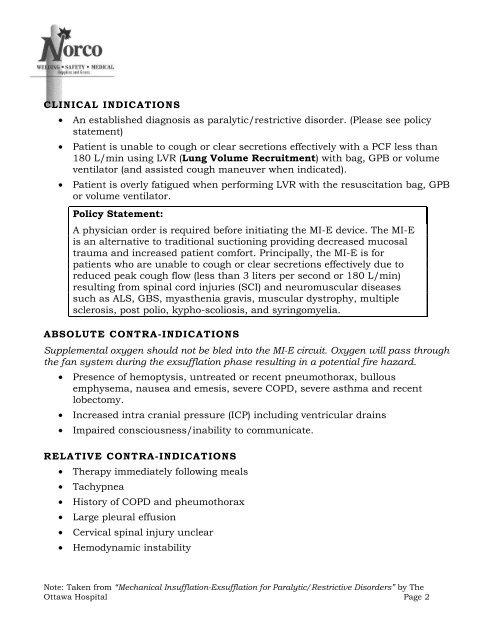COUGH ASSIST - Norco Inc.
COUGH ASSIST - Norco Inc.
COUGH ASSIST - Norco Inc.
Create successful ePaper yourself
Turn your PDF publications into a flip-book with our unique Google optimized e-Paper software.
CLINICAL INDICATIONS<br />
• An established diagnosis as paralytic/restrictive disorder. (Please see policy<br />
statement)<br />
• Patient is unable to cough or clear secretions effectively with a PCF less than<br />
180 L/min using LVR (Lung Volume Recruitment) with bag, GPB or volume<br />
ventilator (and assisted cough maneuver when indicated).<br />
• Patient is overly fatigued when performing LVR with the resuscitation bag, GPB<br />
or volume ventilator.<br />
Policy Statement:<br />
A physician order is required before initiating the MI-E device. The MI-E<br />
is an alternative to traditional suctioning providing decreased mucosal<br />
trauma and increased patient comfort. Principally, the MI-E is for<br />
patients who are unable to cough or clear secretions effectively due to<br />
reduced peak cough flow (less than 3 liters per second or 180 L/min)<br />
resulting from spinal cord injuries (SCI) and neuromuscular diseases<br />
such as ALS, GBS, myasthenia gravis, muscular dystrophy, multiple<br />
sclerosis, post polio, kypho-scoliosis, and syringomyelia.<br />
ABSOLUTE CONTRA-INDICATIONS<br />
Supplemental oxygen should not be bled into the MI-E circuit. Oxygen will pass through<br />
the fan system during the exsufflation phase resulting in a potential fire hazard.<br />
• Presence of hemoptysis, untreated or recent pneumothorax, bullous<br />
emphysema, nausea and emesis, severe COPD, severe asthma and recent<br />
lobectomy.<br />
• <strong>Inc</strong>reased intra cranial pressure (ICP) including ventricular drains<br />
• Impaired consciousness/inability to communicate.<br />
RELATIVE CONTRA-INDICATIONS<br />
• Therapy immediately following meals<br />
• Tachypnea<br />
• History of COPD and pheumothorax<br />
• Large pleural effusion<br />
• Cervical spinal injury unclear<br />
• Hemodynamic instability<br />
Note: Taken from “Mechanical Insufflation-Exsufflation for Paralytic/Restrictive Disorders” by The<br />
Ottawa Hospital Page 2


